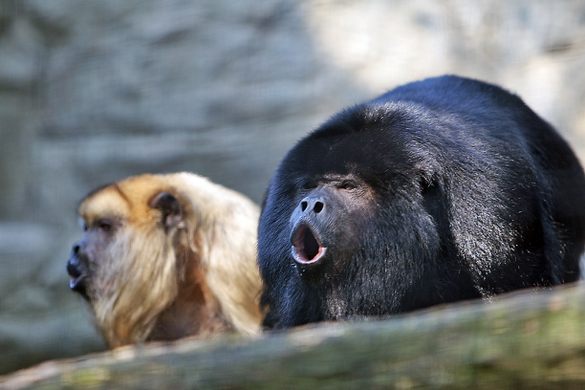Howler Monkeys of Tikal
These roaring primates were considered a divine creature in the cosmology of the Maya.
As you wander the ruins of the ancient citadel of Tikal you are likely to hear, at some point, a thundering guttural roar that reverberates across the forest like the lament of one of the tormented and bellicose demons of Maya mythology.
Listening to this nightmarish noise you could almost be forgiven for thinking that a death metal concert is in progress somewhere in the forest. Follow the source of this sinister sound, if you dare, and you’ll invariably find yourself staring up at a troop of dark-furred monkeys perched nonchalantly among the branches of a ceiba tree.
These are howler monkeys, and the sound they produce that is so emblematic of the Central American rainforest unsurprisingly gives the species its common name of “howler” in the English (“aullador” in Spanish). The rowdy and resonant roaring of this animal can be deafening when heard at close quarters and is so loud it can literally make your ears ring or induce headaches.
This ritualized behavior is performed mainly by the group’s alpha male at dawn, dusk, and often at odd moments throughout the day. The vocalizations serve as a nonviolent means of demarcating territorial boundaries and attracting mates. When other members of the troop join in the cacophony of roaring, it also helps to cement social bonds and give the group a sense of solidarity and unity, making it somewhat similar to the howling of wolves or, in human terms, a church choir.
The howler monkey is almost entirely a folivore, meaning that for the most part it eats leaves and the buds of certain trees, rather than fruit as the spider monkey does. This diet is far lower in energy and therefore the howlers are distinctly slower, more lethargic, and generally far less active primates. They require lots of resting periods, making them far easier to spot than the sympatric spider monkey. Much of the howler monkey’s day is spent chilling out in the boughs of trees in between their folivorous feasts, and although this languorous behavior makes the howler monkey seem to be quite the slacker, it is in fact an evolutionary adaption and physiological necessity.
In the Maya civilization, the monkey was considered a divine animal imbued with profound cultural significance. Although the Mayans held no concept of the scientific theory of evolution as it is currently understood, they conceived of monkeys as being the venerable ancestors of humankind. According to the sacred book of creation myths, the Popol Vuh, primates were a life form that had arisen during one of the many earlier experimental periods of creation by the gods.
According to the myth, the gods were ultimately disappointed with the result, which they found to be too frivolous and rebellious and thus strove to perfect and shape the form of some of the monkeys. In the process of the modification and reshaping, the gods managed to create the human race, and feeling content with their invention gave this “primate 2.0” permission to rule the Earth. As the forerunner of the human race, the monkey, therefore, was perceived to occupy a semi-sacred role within the complex cosmovision of the Mayans.
Due to its sullen and dour appearance, the howler monkey (known as “Batz” in the Mayan language), was connected with seriousness, duty, and work, and therefore associated with scribes. In certain kingdoms and notably in the city of Copan (in present-day Honduras), the figure of the howler monkey scribe was wholly embraced by the ruling elite (in a manner similar to the Hamydryas baboon in ancient Egypt), and huge stone sculptures and stelae depicting these important animals presided over temples.
Know Before You Go
The howler monkeys can be seen very easily at the ruins of Tikal. A troop lives in the ceiba trees around the Temple IV where they can be seen (and heard) most days lounging in the branches. To avoid being defecated or urinated on by monkeys (it happens surprisingly frequently), try to avoid standing directly underneath the trees the animals are sitting in and instead observe them from a distance with binoculars. Please don't feed the monkeys with human food as these can make them sick and encourage an unhealthy habituation to human beings.














Follow us on Twitter to get the latest on the world's hidden wonders.
Like us on Facebook to get the latest on the world's hidden wonders.
Follow us on Twitter Like us on Facebook